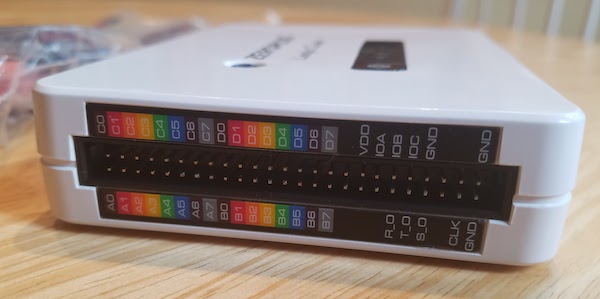
The analog sample rate is limited to 50 MS/sec with up to three channels, with a bandwidth of only 5 MHz, so it’s not going to replace a bench oscilloscope. Each channel can be configured as a digital input, an analog input, or both simultaneously. Unique among the competition, all the new Saleae models except the Logic 4 feature input channels with dual digital/analog capability. 100 MS/sec will be more than enough for most hobbyist purposes.

I’ve personally never built a digital system with external signal speeds above 5 MHz. The Beaglebone Black may have a 1 GHz processor, but its GPIO signals will normally be changing state at a few tens of megahertz at most. It’s important to remember that these are signal speeds, not CPU core speeds. With four or fewer channels in use, the full sampling rate of 500 MS/sec is possible, allowing capture of digital signals up to 125 MHz. Saleae recommends a minimum of 4x oversampling when capturing digital signals, so 100 MS/sec is enough to reliably capture data from digital systems with signal speeds up to 25 MHz. The Logic Pro 8 uses USB 3.0 to push all that sample data to the PC at high speed. Priced at $399, it’s an 8 channel logic analyzer with a max sampling rate of 500 Megasamples/sec, though when using all 8 channels the max sampling rate is reduced to 100 MS/sec. The Logic Pro 8 is the second from the top in Saleae’s product lineup, which also includes the Logic 4, Logic 8, and Logic Pro 16. Modern LAs such as Saleae’s are more likely to be PC peripherals consisting only of the signal acquisition hardware, with all the display and analysis work handled by a software program on the PC. In the old days, an LA was a stand-alone tool, like my ancient HP 1631D. If you do any kind of digital electronics work, a logic analyzer is indispensable. An LA also includes powerful software for triggering, decoding, and dissecting the collected data. Most oscilloscopes have two channels, but typical LAs have at least eight channels, and sometimes 40 or more. But where an oscilloscope is used to view analog waveforms with a continuously varying voltage, a logic analyzer displays digital waveforms whose value is either 0 or 1. In brief, it’s well-polished and good at what it does, though I wish it did more.īut first – what’s a logic analyzer? Much like an oscilloscope, an LA is a tool for examining electrical waveforms in a running circuit – the so-called “device under test” or DUT. Last month the nice folks at Saleae were kind enough to send me a new Logic Pro 8 for review, so I recently had a chance to test the hardware first-hand. For 2014 the company revamped its product line, replacing all its existing models with four new products.


When Saleae’s first USB-based logic analyzer burst onto the electronics scene in 2008, it was praised for its ease of use and low cost.


 0 kommentar(er)
0 kommentar(er)
